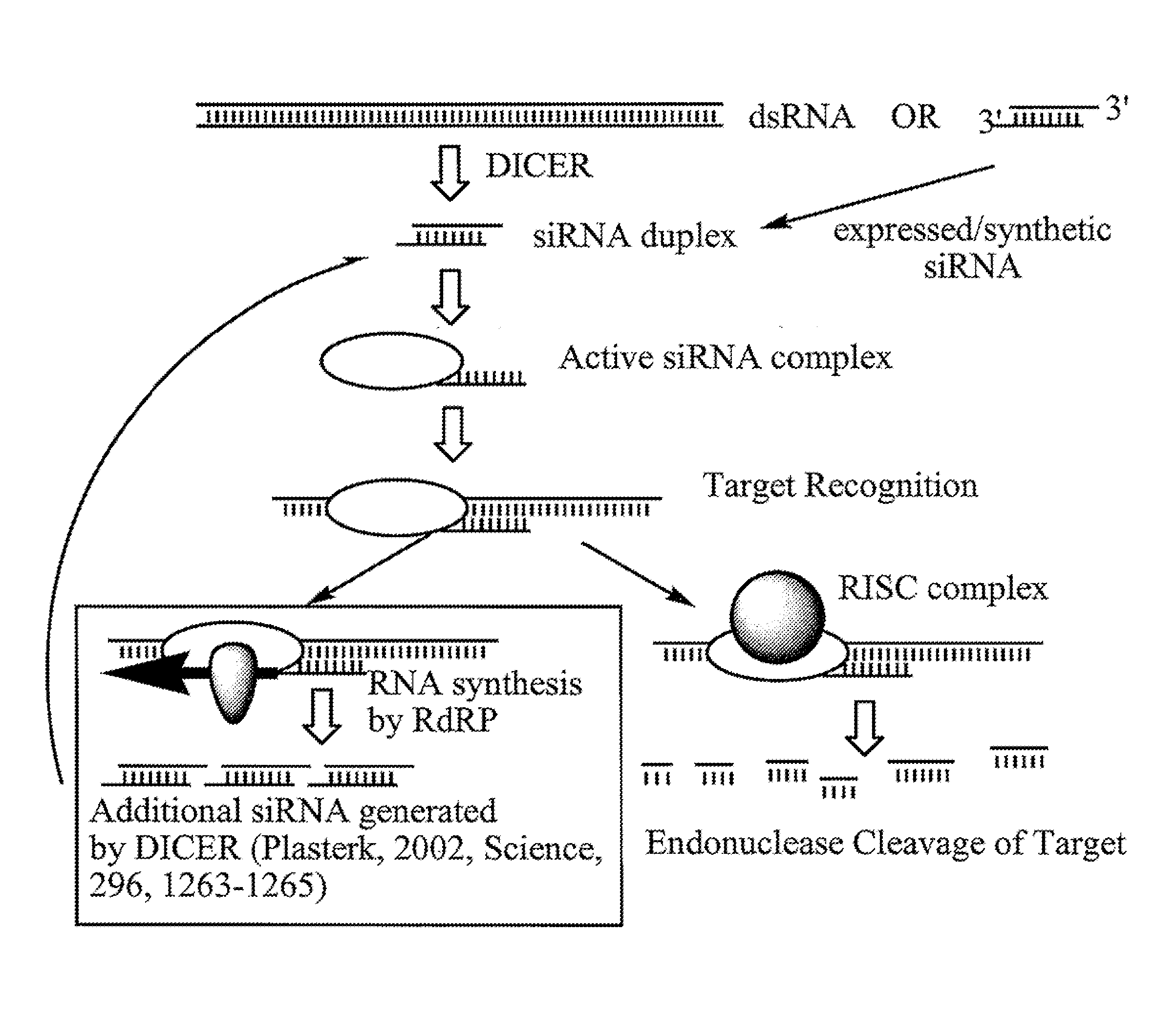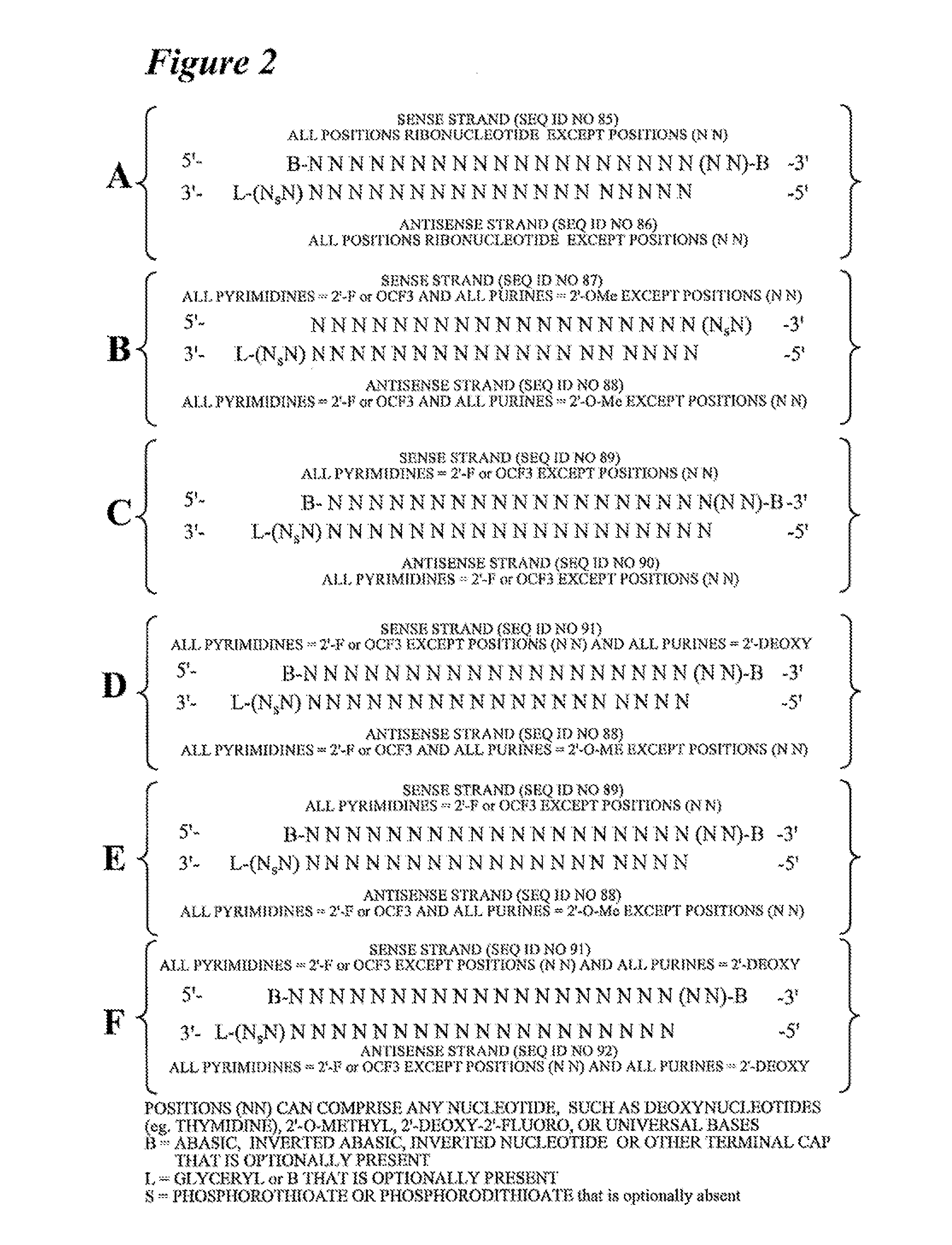RNA Interference Mediated Inhibition of Apoptosis Signal-Regulating Kinase 1 (ASK1) Gene Expression Using Short Interfering Nucleic Acid (siNA)
a technology of apoptosis signal-regulating kinase and interfering nucleic acid, which is applied in the direction of activity regulation, organic chemistry, drug compositions, etc., can solve the problems of irreversible loss of lung function, and increased oxidant burden during active phase of diseas
- Summary
- Abstract
- Description
- Claims
- Application Information
AI Technical Summary
Benefits of technology
Problems solved by technology
Method used
Image
Examples
example 1
Design, Synthesis, and Identification of siNAs Active Against ASK1
[0477]ASK1 siNA Synthesis
[0478]A series of 28 siNA molecules were designed, synthesized and evaluated for efficacy against ASK1. The primary criteria for design of ASK1 for human siNAs were (i) homology between two species (human and mouse) and (ii) high efficacy scores as determined by a proprietary algorithm. Mouse sequences were also looked at for use in animal models. The sequences of the siNAs that were designed, synthesized, and evaluated for efficacy against ASK1 are described in Table 1a (target sequences) and Table 1b (modified sequences).
TABLE 1aASK-1 Target Sequences, noting target sites.TargetSEQ DuplexSiteIDIDTarget Sequence(human)HomologyNO:25374-DCGCACUGGGAACUACACCUU 978h (1 mm m)125375-DCGGAUGAAAAUAGAAACCAA4101h225376-DCGCACCAGAAAUAAUAGAUA2900h325377-DCGGAAGACCAAGACAAAAUU3538h425378-DCCGGAAGACCAAGACAAAAU3537h525379-DCCGAUGGAAAUUCUAAAAAU4507h625380-DCGAUGGAAAUUCUAAAAAUU4508h725381-DCGCGAGGCCCUGCAGAGCUU ...
example 2
In Vivo Assessment of Actions of siNAs Administered Topically to the Airway
[0521]Following identification of active siNA constructs in vitro, the activities of the siNAs following topical administration to the airway can be assessed in a variety of laboratory species—a typical example is rat, using the methodology summarised below. siNA, an appropriate scrambled control, or vehicle are injected in 200 μl volume into the trachea, via a cannula placed trans-orally, whilst the animals are anaesthetised briefly using isoflurane (4.5% in oxygen) and nitrous oxide (anaesthetics delivered in a ratio of 1:3). In order to facilitate administration of material, animals are supine and placed on a dosing table at an angle of approximately 45° in order to facilitate visualisation of the airway via a cold light source placed over the throat. Alternatively, the anaesthetised animals are dosed intranasally via a pipette (dosing volume 25 μl per nostril). In other studies, conscious rodents are plac...
example 3
Preparation of Nanoparticle Encapsulated siNA / Carrier Formulations
General LNP Preparation
[0523]siNA nanoparticle solutions are prepared by dissolving siNAs and / or carrier molecules in 25 mM citrate buffer (pH 4.0) at a concentration of 0.9 mg / mL. Lipid solutions are prepared by dissolving a mixture of cationic lipid (e.g., CLinDMA or DOBMA, see structures and ratios for Formulations in Table 10), DSPC, Cholesterol, and PEG-DMG (ratios shown in Table 10) in absolute ethanol at a concentration of about 15 mg / mL. The nitrogen to phosphate ratio is approximate to 3:1.
[0524]Equal volume of siNA / carrier and lipid solutions are delivered with two FPLC pumps at the same flow rates to a mixing T connector. A back pressure valve is used to adjust to the desired particle size. The resulting milky mixture is collected in a sterile glass bottle. This mixture is then diluted slowly with an equal volume of citrate buffer, and filtered through an ion-exchange membrane to remove any free siNA / carrie...
PUM
| Property | Measurement | Unit |
|---|---|---|
| Fraction | aaaaa | aaaaa |
| Volume | aaaaa | aaaaa |
| Volume | aaaaa | aaaaa |
Abstract
Description
Claims
Application Information
 Login to View More
Login to View More - R&D
- Intellectual Property
- Life Sciences
- Materials
- Tech Scout
- Unparalleled Data Quality
- Higher Quality Content
- 60% Fewer Hallucinations
Browse by: Latest US Patents, China's latest patents, Technical Efficacy Thesaurus, Application Domain, Technology Topic, Popular Technical Reports.
© 2025 PatSnap. All rights reserved.Legal|Privacy policy|Modern Slavery Act Transparency Statement|Sitemap|About US| Contact US: help@patsnap.com



